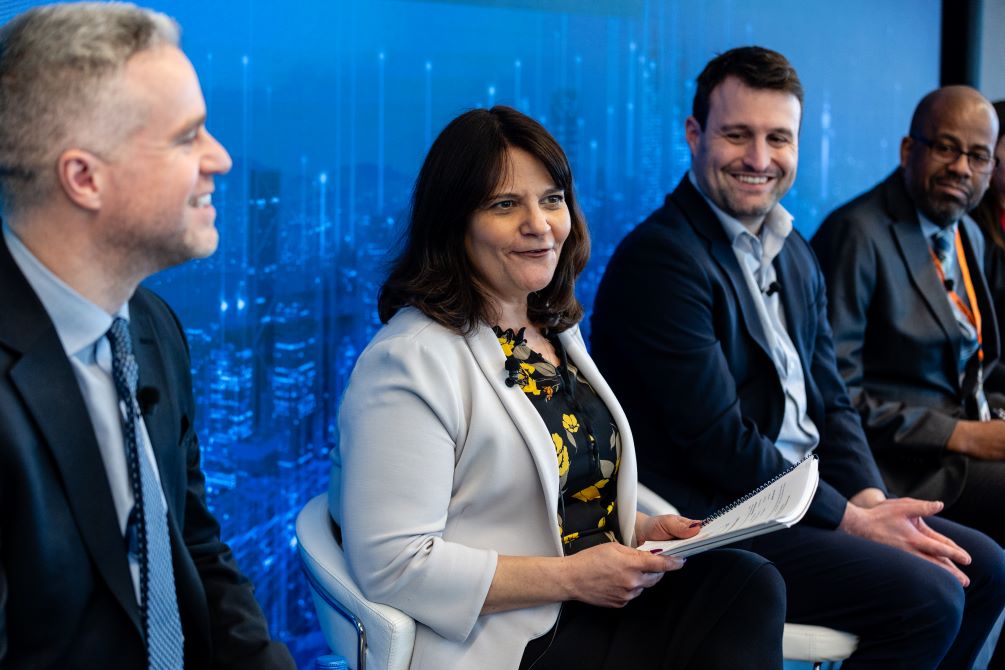Here’s what you need to know about hydrogen:
The U.S. Department of Energy (DOE) recently announced the historic investment of $7 billion to fund the country’s first clean hydrogen hubs. Two of the seven proposed regional hubs will be in California and Texas, where Sempra companies have vast energy networks and are well-positioned to help develop the clean hydrogen economy.
More than $1 billion is expected to be allocated to the Alliance for Renewable Clean Hydrogen Energy Systems (ARCHES), the California hydrogen hub where Sempra California’s SoCalGas is a proud collaborator ready to leverage its innovation in hydrogen. Additionally, more than $1 billion is expected to be allocated to HyVelocity, the Gulf Coast hydrogen hub where Sempra Infrastructure is one of seven core industry partners.
What is hydrogen and why is it important?
Hydrogen is the most abundant element in the universe and is well-positioned to play a major role in the low-carbon energy mix due to its versatile and sustainable qualities. Hydrogen can be produced and consumed with zero emissions when produced from renewable energy sources. It can also be produced from natural gas to create a low-emissions gas that can complement renewable energy to help further advance the global energy transition underway.
From providing a potential solution to the renewable energy storage dilemma, to supporting the transition to low- and zero-emission vehicles, hydrogen technology holds great promise for our cleaner energy future.
Sempra California’s utilities SoCalGas and SDG&E are participating in more than 20 hydrogen research and demonstration projects that aim to enhance grid resiliency and help decarbonize the economy.
Developing necessary infrastructure
Once renewable energy is converted into hydrogen, it needs to be stored and transported safely. Due to the large amount of renewable generation in California, utilizing the extensive natural gas pipeline network is an attractive and potentially scalable option for storing and transporting hydrogen.
Hydrogen hubs like those designated and funded by the DOE are envisioned to accelerate the use of hydrogen when all stakeholders come together in regional hubs. Each hub is expected to be supported by businesses that will produce, process, deliver and store hydrogen before it goes to consumers, such as hard-to-abate industries, including the transportation sector. However, modern infrastructure is the key enabler of the hydrogen economy.
Sempra companies have significant expertise in building, managing and operating pipeline infrastructure — infrastructure that is necessary to advance the hydrogen economy. In addition to upstream production facilities, the hydrogen industry needs pipelines, storage and potentially import and export terminals to satisfy the global hydrogen market that may emerge as countries around the world look to decarbonize.
Achieving cleaner transportation
The energy transition will need to address the transportation sector, which is the largest contributor to greenhouse gases in California. That’s why we are actively exploring how hydrogen and fuel cell electric vehicles could provide a much greener option compared to ones powered by gasoline.
Fuel cells are two to three times more efficient than gasoline, according to the U.S. Energy Information Administration. With a much longer range and shorter fueling time compared with battery electric vehicles, fuel cell electric vehicles have the potential to become an important component of the energy transition and the hydrogen economy.
SoCalGas is underway advancing fuel cell technology and was previously awarded $7 million in funding from the DOE to advance lower emissions vehicle technologies such as fuel cell technology that will power trucks and transit buses.
Advancing the energy transition
We believe the future of energy is clean electrons and cleaner molecules working in tandem — and hydrogen fits squarely in the mix. Across the Sempra family of companies, we are committed to furthering the energy transition across North America through innovation in hydrogen technology and more.
This article contains statements that constitute forward-looking statements within the meaning of the Private Securities Litigation Reform Act of 1995. Forward-looking statements are based on assumptions with respect to the future, involve risks and uncertainties, and are not guarantees. Future results may differ materially from those expressed or implied in any forward-looking statement. These forward-looking statements represent our estimates and assumptions only as of the date of this article. We assume no obligation to update or revise any forward-looking statement as a result of new information, future events or otherwise.
In this article, forward-looking statements can be identified by words such as “believes,” “expects,” “intends,” “anticipates,” “contemplates,” “plans,” “estimates,” “projects,” “forecasts,” “should,” “could,” “would,” “will,” “confident,” “may,” “can,” “potential,” “possible,” “proposed,” “in process,” “construct,” “develop,” “opportunity,” “initiative,” “target,” “outlook,” “optimistic,” “poised,” “maintain,” “continue,” “progress,” “advance,” “goal,” “aim,” “commit,” or similar expressions, or when we discuss our guidance, priorities, strategy, goals, vision, mission, opportunities, projections, intentions or expectations.
Factors, among others, that could cause actual results and events to differ materially from those expressed or implied in any forward-looking statement include risks and uncertainties relating to: California wildfires, including potential liability for damages regardless of fault and any inability to recover all or a substantial portion of costs from insurance, the wildfire fund established by California Assembly Bill 1054, rates from customers or a combination thereof; decisions, investigations, inquiries, regulations, denials or revocations of permits, consents, approvals or other authorizations, renewals of franchises, and other actions by (i) the California Public Utilities Commission (CPUC), Comisión Reguladora de Energía, U.S. Department of Energy, U.S. Federal Energy Regulatory Commission, Public Utility Commission of Texas, and other governmental and regulatory bodies and (ii) the U.S., Mexico and states, counties, cities and other jurisdictions therein and in other countries where we do business; the success of business development efforts, construction projects and acquisitions and divestitures, including risks in (i) being able to make a final investment decision, (ii) completing construction projects or other transactions on schedule and budget, (iii) realizing anticipated benefits from any of these efforts if completed, and (iv) obtaining the consent or approval of third parties; litigation, arbitrations, property disputes and other proceedings, and changes to laws and regulations, including those related to the energy industry in Mexico; cybersecurity threats, including by state and state-sponsored actors, of ransomware or other attacks on our systems or the systems of third parties with which we conduct business, including the energy grid or other energy infrastructure, all of which have become more pronounced due to recent geopolitical events; our ability to borrow money on favorable terms and meet our obligations, including due to (i) actions by credit rating agencies to downgrade our credit ratings or place those ratings on negative outlook or (ii) rising interest rates and inflation; failure of foreign governments, state-owned entities and our counterparties to honor their contracts and commitments; the impact on affordability of San Diego Gas & Electric Company’s (SDG&E) and Southern California Gas Company’s (SoCalGas) customer rates and their cost of capital and on SDG&E’s, SoCalGas’ and Sempra Infrastructure’s ability to pass through higher costs to customers due to (i) volatility in inflation, interest rates and commodity prices, (ii) with respect to SDG&E’s and SoCalGas’ businesses, the cost of the clean energy transition in California, and (iii) with respect to Sempra Infrastructure’s business, volatility in foreign currency exchange rates; the impact of climate and sustainability policies, laws, rules, regulations, disclosures and trends, including actions to reduce or eliminate reliance on natural gas, increased uncertainty in the political or regulatory environment for California natural gas distribution companies, the risk of nonrecovery for stranded assets, and our ability to incorporate new technologies; weather, natural disasters, pandemics, accidents, equipment failures, explosions, terrorism, information system outages or other events that disrupt our operations, damage our facilities or systems, cause the release of harmful materials or fires or subject us to liability for damages, fines and penalties, some of which may not be recoverable through regulatory mechanisms or insurance or may impact our ability to obtain satisfactory levels of affordable insurance; the availability of electric power, natural gas and natural gas storage capacity, including disruptions caused by failures in the transmission grid, pipeline system or limitations on the withdrawal of natural gas from storage facilities; Oncor Electric Delivery Company LLC’s (Oncor) ability to reduce or eliminate its quarterly dividends due to regulatory and governance requirements and commitments, including by actions of Oncor’s independent directors or a minority member director; changes in tax and trade policies, laws and regulations, including tariffs, revisions to international trade agreements and sanctions, any of which may increase our costs, reduce our competitiveness, impact our ability to do business with certain counterparties, or impair our ability to resolve trade disputes; and other uncertainties, some of which are difficult to predict and beyond our control.
These risks and uncertainties are further discussed in the reports that Sempra has filed with the U.S. Securities and Exchange Commission (SEC). These reports are available through the EDGAR system free-of-charge on the SEC’s website, sec.gov, and on Sempra’s website, sempra.com. Investors should not rely unduly on any forward-looking statements.
Sempra Infrastructure, Sempra Infrastructure Partners, Sempra Texas, Sempra Texas Utilities, Oncor and Infraestructura Energética Nova, S.A.P.I. de C.V. (IEnova) are not the same companies as the California utilities, SDG&E or SoCalGas, and Sempra Infrastructure, Sempra Infrastructure Partners, Sempra Texas, Sempra Texas Utilities, Oncor and IEnova are not regulated by the CPUC.









